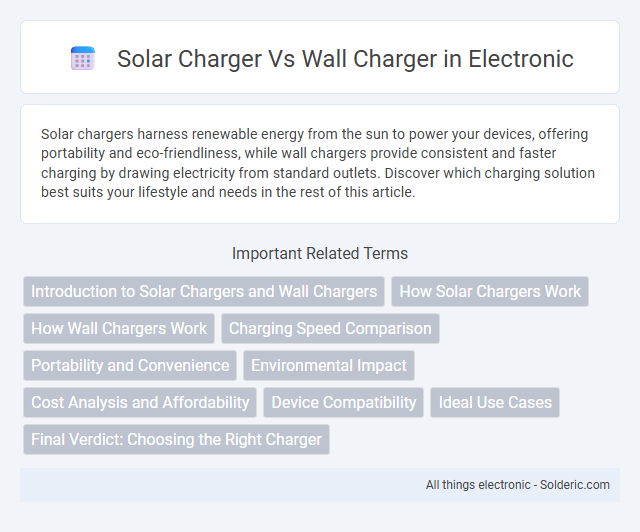Solar chargers harness renewable energy from the sun to power your devices, offering portability and eco-friendliness, while wall chargers provide consistent and faster charging by drawing electricity from standard outlets. Discover which charging solution best suits your lifestyle and needs in the rest of this article.
Comparison Table
| Feature | Solar Charger | Wall Charger |
|---|---|---|
| Power Source | Sunlight (solar energy) | Electric grid (AC power) |
| Charging Speed | Slow to moderate, depends on sunlight intensity | Fast and consistent |
| Portability | Highly portable, ideal for outdoor use | Less portable, requires power outlet |
| Environmental Impact | Eco-friendly, renewable energy | Depends on energy source, may use fossil fuels |
| Usage Dependency | Works only in daylight, affected by weather | Works anytime, independent of weather |
| Cost | Higher initial cost, no ongoing power cost | Lower initial cost, ongoing electricity cost |
Introduction to Solar Chargers and Wall Chargers
Solar chargers harness photovoltaic cells to convert sunlight into electrical energy, providing a portable and eco-friendly power source ideal for outdoor use. Wall chargers connect to electrical outlets to deliver consistent and rapid charging for devices, relying on grid electricity for power. Both chargers serve essential roles in device recharging, with solar chargers emphasizing renewable energy and mobility, while wall chargers prioritize speed and reliability.
How Solar Chargers Work
Solar chargers convert sunlight into electrical energy through photovoltaic cells, which generate direct current (DC) when exposed to sunlight. These cells consist of semiconductor materials, typically silicon, that create an electric field to separate electrons and protons, producing power for charging devices. Unlike wall chargers that draw electricity from an AC power outlet, solar chargers provide portable, renewable energy ideal for outdoor and off-grid applications.
How Wall Chargers Work
Wall chargers convert AC electricity from power outlets into DC electricity compatible with electronic devices, utilizing transformers and rectifiers for efficient power delivery. They provide a stable and consistent energy output, ensuring rapid device charging regardless of weather or location. Designed for indoor use, wall chargers rely on grid power, offering higher charging speeds compared to solar chargers which depend on sunlight.
Charging Speed Comparison
Solar chargers typically offer slower charging speeds compared to wall chargers due to their reliance on sunlight intensity and weather conditions, which can affect energy output significantly. Wall chargers provide consistent, high-speed charging by directly drawing power from the electrical grid, ensuring your devices charge quickly and efficiently. Understanding this difference helps you choose the best option for your needs, especially when fast charging is a priority.
Portability and Convenience
Solar chargers excel in portability and convenience due to their lightweight design and ability to harness sunlight anywhere, eliminating the need for electrical outlets. Wall chargers require access to a power source, limiting their use to indoor or fixed locations. This makes solar chargers ideal for outdoor enthusiasts and travelers seeking reliable, on-the-go device charging solutions.
Environmental Impact
Solar chargers significantly reduce environmental impact by harnessing renewable energy from the sun, producing zero emissions during operation. Wall chargers rely on electricity often derived from fossil fuels, contributing to carbon dioxide emissions and resource depletion. Choosing solar chargers supports sustainable energy use and lowers the carbon footprint compared to conventional wall charging methods.
Cost Analysis and Affordability
Solar chargers typically involve a higher initial investment compared to wall chargers, but they offer long-term savings by harnessing free, renewable energy from the sun. Wall chargers are generally more affordable upfront but incur ongoing electricity costs, which can add up over time depending on usage. Your choice between the two should consider both immediate budget constraints and potential long-term energy savings.
Device Compatibility
Solar chargers offer broad device compatibility, supporting smartphones, tablets, and even laptops with USB and USB-C outputs, making them versatile for outdoor use. Wall chargers provide stable power with higher wattage options, ensuring fast and efficient charging for a wide range of devices, including high-demand gadgets. Your choice depends on whether you prioritize portability and eco-friendly charging or maximum power delivery and reliability.
Ideal Use Cases
Solar chargers are ideal for outdoor activities such as camping, hiking, and emergency situations where access to electrical outlets is limited, providing eco-friendly power using sunlight. Wall chargers offer fast, reliable charging for everyday use at home, office, or any location with stable electricity, supporting high-speed USB and wireless charging for smartphones, tablets, and laptops. Choosing between a solar charger and a wall charger depends heavily on mobility needs and charging speed priorities.
Final Verdict: Choosing the Right Charger
Solar chargers offer eco-friendly, portable charging solutions ideal for outdoor use, while wall chargers provide faster, consistent power for everyday indoor needs. Choosing the right charger depends on lifestyle priorities such as sustainability, convenience, and charging speed. For frequent travelers or campers, solar chargers enhance energy independence, whereas wall chargers suit stationary charging with reliable, high-output energy.
solar charger vs wall charger Infographic

 solderic.com
solderic.com